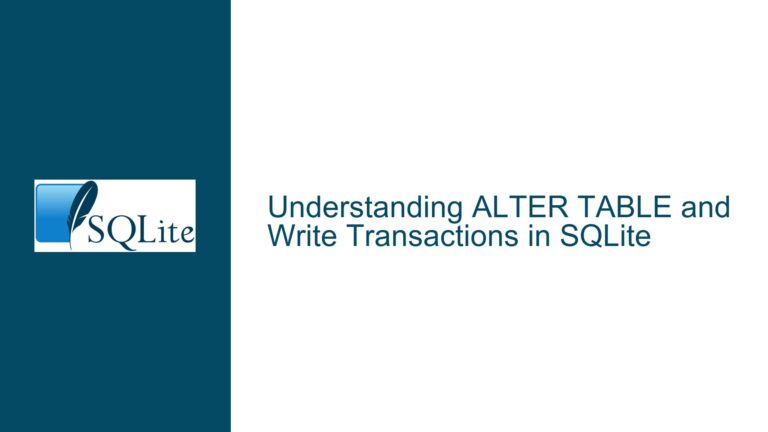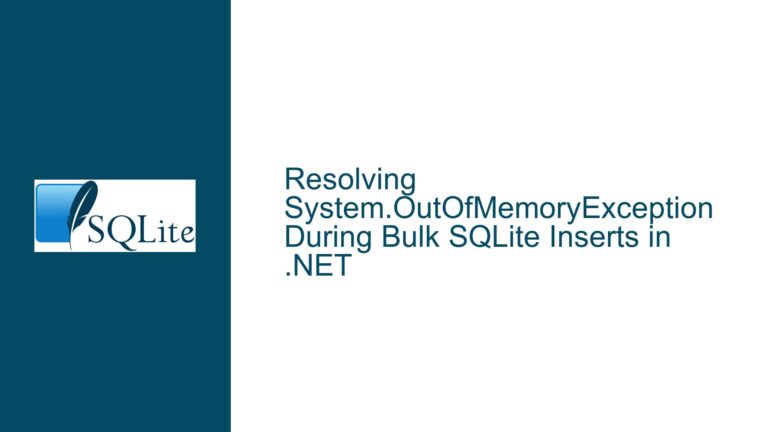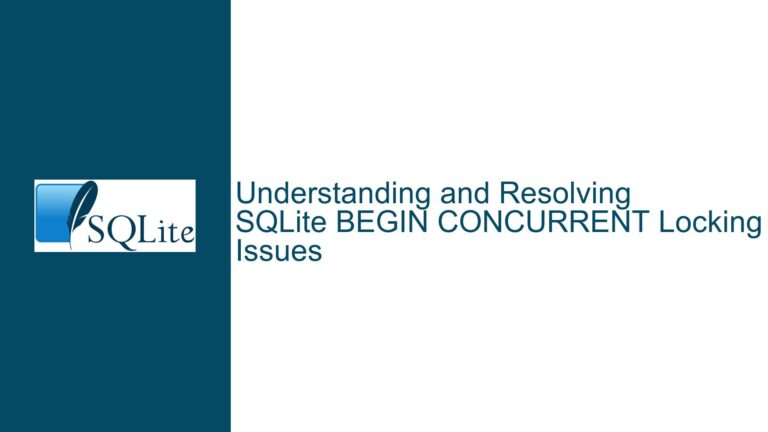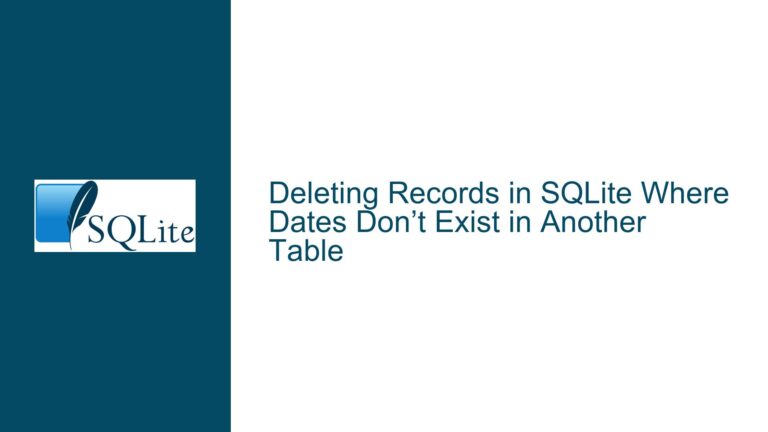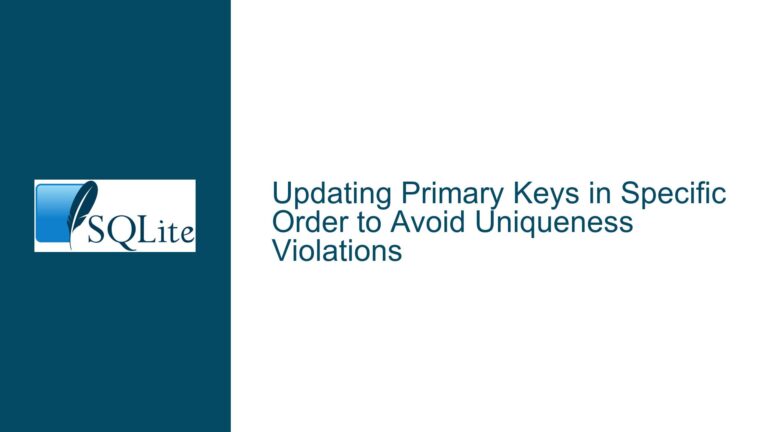Resolving SQLite “Database is Locked” Error During Consecutive Write Operations
Understanding Write Contention & Connection Management in SQLite Environments
Database Locking Mechanics and Concurrent Access Patterns
The "database is locked" error in SQLite occurs when multiple processes or connections attempt simultaneous write access to the same database file without proper transaction isolation. SQLite employs a file-based locking mechanism with five lock states (UNLOCKED, SHARED, RESERVED, PENDING, EXCLUSIVE), where transitions between states enforce serialized write operations. When a program writes to the database, it must obtain an EXCLUSIVE lock, which conflicts with other write attempts. The error manifests when:
- A previous connection maintains an open transaction without COMMIT/ROLLBACK
- File handles remain open after program termination
- External processes (e.g., browsers, backup tools) retain file access
- Connection pools exceed SQLite’s concurrent write capacity
In the described scenario, the program’s database update logic creates implicit transactions through cursor operations. If the application closes connections without finalizing pending transactions, SQLite’s lock file (*.sqlite-wal or *.sqlite-journal) persists, blocking subsequent access attempts. The Firefox browser reference indicates potential third-party file locking through privacy features that maintain cached database access, particularly with WebSQL implementations or extension databases.
Connection Lifecycle Mismanagement and External Interference
Improper resource cleanup constitutes the primary error source. SQLite connections require explicit closure with connection.close() after committing transactions. Cursor closure alone doesn’t release database locks. Common failure patterns include:
Uncommitted Transactions
# Dangerous pattern leaving implicit transaction open
cursor.execute("UPDATE table SET col=1 WHERE id=2")
connection.close() # Fails to commit, leaves -journal file
Zombie Connections
Background threads or event loops maintaining dormant connections after program termination, often seen in async frameworks or ORM layers with connection pooling.
File Handle Inheritance
Child processes spawned with inherited database file descriptors (subprocess.Popen in Python with default inheritence).
Antivirus Interference
Real-time scanning tools locking database files during write operations.
Network Drive Latency
Storing SQLite files on SMB/NFS mounts with slow lock release times.
Firefox Privacy Settings
Strict privacy configurations (as per reply #2) prolong browser retention of WebSQL database locks even after tab closure. Firefox’s Storage API maintains exclusive access to *.sqlite files until explicit context destruction.
Comprehensive Lock Resolution Protocol and Preventive Configuration
Step 1: Audit Connection Handling
Implement explicit transaction control with error handling:
import sqlite3
from contextlib import contextmanager
@contextmanager
def sqlite_connection(db_path):
conn = sqlite3.connect(db_path, timeout=20) # Increase timeout
try:
yield conn
conn.commit() # Explicit commit before close
except sqlite3.Error as e:
conn.rollback()
raise e
finally:
if conn:
conn.close()
# Usage:
with sqlite_connection('app.db') as conn:
cursor = conn.cursor()
cursor.execute("UPDATE data SET value=? WHERE key=?", (new_val, key))
Step 2: Identify External Lock Holders
On Windows:
- Use Process Explorer (Sysinternals) to search for handles to *.sqlite files
- Run
handle64.exe -p <PID>for specific process analysis
On Linux/macOS:
lsof +D /path/to/database | grep '.sqlite'
fuser /path/to/database.sqlite
Step 3: Configure Firefox Privacy Settings
- Navigate to
about:preferences#privacy - Under "Enhanced Tracking Protection", select "Standard"
- Access
about:configand modify:privacy.sanitize.pending→[]privacy.clearOnShutdown.offlineApps→true
Step 4: Optimize SQLite Parameters
Adjust connection parameters to handle contention:
# Set journal mode to WAL for concurrent reads
conn.execute('PRAGMA journal_mode=WAL;')
# Increase busy timeout to 30 seconds
conn.execute('PRAGMA busy_timeout=30000;')
# Enable foreign key constraints (prevents locked parent rows)
conn.execute('PRAGMA foreign_keys=ON;')
Step 5: Filesystem-Level Mitigations
- Disable antivirus real-time scanning on database directories
- Mount database storage on local SSDs instead of network drives
- Set proper file permissions:
chmod 644 database.sqlite - Use
F_SETLK(fcntl) in C extensions for manual lock control
Step 6: Application Architecture Adjustments
- Implement retry logic with exponential backoff:
import time
from sqlite3 import OperationalError
MAX_RETRIES = 5
RETRY_DELAY = 0.1
def execute_with_retry(cursor, query, params):
attempts = 0
while attempts < MAX_RETRIES:
try:
cursor.execute(query, params)
return
except OperationalError as e:
if 'locked' not in str(e):
raise
time.sleep(RETRY_DELAY * (2 ** attempts))
attempts += 1
raise OperationalError(f"Failed after {MAX_RETRIES} retries")
Step 7: Post-Mortem Lock Removal
For residual locks after crashes:
- Delete -shm/-wal files only when no active connections exist
- Use
sqlite3 database.sqlite 'PRAGMA wal_checkpoint(TRUNCATE);' - On Windows, utilize
movefile.exefrom Sysinternals to force-delete locked files
Step 8: Connection Pool Tuning
When using ORMs like SQLAlchemy:
from sqlalchemy.pool import NullPool
engine = create_engine('sqlite:///app.db', poolclass=NullPool)
Disable connection pooling to prevent stale connections from retaining locks.
Preventive Monitoring
Implement lock monitoring triggers:
CREATE TABLE lock_events (
id INTEGER PRIMARY KEY,
event_type TEXT,
timestamp DATETIME DEFAULT CURRENT_TIMESTAMP
);
-- Attach to SQLite's unlock notification API via extension
SELECT sqlite3_unlock_notify(db, callback, NULL);
Advanced: Using Exclusive Locking Mode
For single-writer scenarios:
conn = sqlite3.connect('file:app.db?mode=rwc&locking_mode=EXCLUSIVE', uri=True)
Caution: This mode prevents all concurrent access until connection closure.
By systematically addressing connection lifecycle management, external process interference, and SQLite configuration nuances, developers can eliminate "database is locked" errors while maintaining data integrity across application restarts and concurrent access scenarios.

